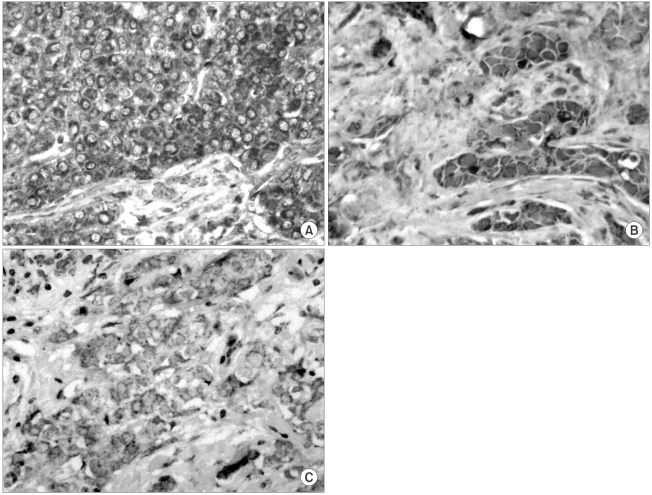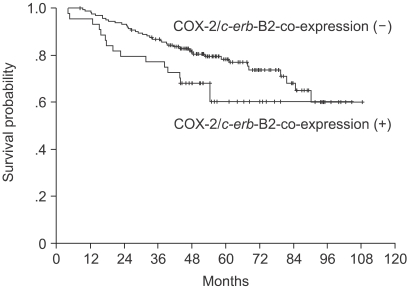Cancer Res Treat.
2004 Jun;36(3):192-198.
Clinical Value of Cyclooxygenase-2 Expression in Human Breast Carcinoma
- Affiliations
-
- 1Department of Medicine, Asan Medical Center, University of Ulsan College of Medicine, Seoul, Korea. drjiny@amc.seoul.kr
- 2Department of Surgery, Asan Medical Center, University of Ulsan College of Medicine, Seoul, Korea.
- 3Department of Pathology, Asan Medical Center, University of Ulsan College of Medicine, Seoul, Korea.
- 4Department of Medicine, University of Hanyang College of Medicine, Seoul, Korea.
Abstract
- PURPOSE
To determine whether COX-2 expression is associated with clinicopathological parameters, including c-erb-B2 overexpression and angiogenesis, and the disease- free survival of patients with operable breast cancer.
MATERIALS AND METHODS
Paraffin-embedded tissue samples were selected from 205 patients surgically resected for breast cancer, between 1991 and 1997, and followed- up for at least 4 years. Samples were immunohistochemically stained with antibodies to COX-2, c-erb-B2 and CD34.
RESULTS
COX-2 and c-erb-B2 expressions were detected in 118/205 (57.6%) and 58/205 (28.3%) patients, respectively. COX-2 expression was significantly higher in c-erb-B2 positive than c-erb-B2 negative tumors (75.9% vs. 49.7%, p-value 0.001). COX-2 expression was positively correlated with microvessel count (13.3+/-8.0 vs. 6.6+/-7.0, p-value 0.050), but not with other clinicopathological characteristics, including tumor size, involved axil lary lymph nodes and estrogen or progesterone receptor status. Although COX-2 expression itself was not a prognostic marker, breast cancer patients with tumors that co-expressed both COX-2 and c-erb-B2 had a poorer 5-year disease-free survival rate than those that did not (60.2% vs. 78.3%, p-value 0.0527).
CONCLUSION
Our data suggest that COX-2 expression occurs frequently in c-erb-B2 positive breast cancer, and co-expression of COX-2 and c-erb-B2 may be a useful prognostic marker in patients with operable breast cancer.
Keyword
MeSH Terms
Figure
Reference
-
1. Thun MJ, Namboodiri MM, Heath CW Jr. Aspirin use and reduced risk of fatal colon cancer. N Engl J Med. 1991; 325:1593–1596. PMID: 1669840.
Article2. Mohammed SI, Knapp DW, Bostwick DG, Foster RS, Khan KN, Masferrer JL, Woerner BM, Snyder PW, Koki AT. Expression of cyclooxygenase-2 (COX-2) in human invasive transitional cell carcinoma (TCC) of the urinary bladder. Cancer Res. 1999; 59:5647–5650. PMID: 10582676.3. Chan G, Boyle JO, Yang EK, Zhang F, Sacks PG, Shah JP, Edelstein D, Soslow RA, Koki AT, Woerner BM, Masferrer JL, Dannenberg AJ. Cyclooxygenase-2 expression is up-regulated in squamous cell carcinoma of the head and neck. Cancer Res. 1999; 59:991–994. PMID: 10070952.4. Parrett ML, Harris RE, Joarder FS, Ross MS, Clausen KP, Robertson FM. Cyclooxygenase-2 expression in human breast cancer. Int J Oncol. 1997; 10:503–507.5. Bennett A, Charlier EM, McDonald AM, Simpson JS, Stamford IF, Zebro T. Prostaglandins and breast cancer. Lancet. 1977; 2:624–626. PMID: 71446.
Article6. Liu XH, Rose DP. Differential expression and regulation of cyclooxygenase-1 and -2 in two human breast cancer cell line. Cancer Res. 1996; 15:5125–5127. PMID: 8912844.7. Khuder SA, Mutgi AB. Breast cancer and NSAID use: a meta-analysis. Br J Cancer. 2001; 84:1188–1192. PMID: 11336469.
Article8. Harris RE, Alshafie GA, Abou-Issa HM, Seibert K. Chemoprevention of breast cancer in rats by celecoxib, a cyclooxygenase-2 inhibitor. Cancer Res. 2000; 60:2101–2103. PMID: 10786667.9. Kang HJ, Gong G, Jang SJ, Jung PJ, Park CK. Expression of cyclooxygenase-2 in human breast carcinoma: Relevance to tumor tumor angiogenesis and expression of estrogen receptor. Cancer Res Treat. 2001; 33:286–295.10. Gately S. The contributions of cyclooxygenase-2 to tumor angiogenesis. Cancer Metastasis Rev. 2000; 19:19–27. PMID: 11191059.11. Sawaoka H, Tsuji S, Tsujii M, Gunawan ES, Sasaki Y, Kawano S, Hori M. Cyclooxygenase inhibitors suppress angiogenesis and reduce tumor growth in vivo. Lab Invest. 1999; 79:1469–1477. PMID: 10616198.12. Brueggemeier RW, Quinn AL, Parrett ML, Joarder FS, Harris RE, Robertson FM. Correlation of aromatase and cyclooxygenase gene expression in human breast cancer specimens. Cancer Letters. 1999; 140:27–35. PMID: 10403538.
Article13. Kononen J, Bubendorf L, Kallioniemi A, Barlund M, Schraml P, Leighton S, Torhorst J, Mihatsch MJ, Sauter G, Kallioniemi OP. Tissue microarrays for high-throughput molecular profiling of tumor specimens. Nat Med. 1998; 4:844–847. PMID: 9662379.
Article14. Ristimaki A, Sivula A, Lundin J, Lundin M, Salminen T, Haglund C, Joensuu H, Isola J. Prognostic significance of elevated cyclooxygenase-2 expression in breast cancer. Cancer Res. 2002; 62:632–635. PMID: 11830510.15. Weidner N, Semple JP, Welch WR, Folkman J. Tumor angiogenesis and metastasis correlation in invasive breast carcinoma. N Engl J Med. 1991; 324:1–4. PMID: 1701519.16. Slamon DJ, Leyland-Jones B, Shak S, Fuchs H, Paton V, Bajamonde A, Fleming T, Eiermann W, Wolter J, Pegram M, Baselga J, Norton L. Use of chemotherapy plus a monoclonal antibody against HER2 for metastatic breast cancer that overexpresses HER2. N Engl J Med. 2001; 344:783–792. PMID: 11248153.
Article17. Hwang D, Scollard D, Byrne J, Levine E. Expression of cyclooxygenase-1 and cyclooxygenase-2 in human breast cancer. J Natl Cancer Inst. 1998; 90:455–460. PMID: 9521170.
Article18. Half E, Tang XM, Gwyn K, Sahin A, Wathen K, Sinicrope FA. Cyclooxygenase-2 expression in human breast cancers and adjacent ductal carcinoma in situ. Cancer Res. 2002; 62:1676–1681. PMID: 11912139.19. Denkert C, Winzer KJ, Muller BM, Weichert W, Pest S, Kobel M, Kristiansen G, Reles A, Siegert A, Guski H, Hauptmann S. Elevated expression of cyclooxygenase-2 is a negative prognostic factor for disease-free survival and overall survival in patients with breast carcinoma. Cancer. 2003; 97:2978–2987. PMID: 12784332.20. Subbaramaiah K, Norton L, Gerald W, Dannengerg AJ. Cyclooxygenase-2 is overexpressed in HER-2/neu-positive breast cancer. Evidence for involvement of AP-1 and PEA3. J Biol Chem. 2002; 77:18649–18657. PMID: 11901151.21. Vadlamudi R, Mandal M, Adam L, Steinbach G, Mendelsohn J, Kumar R. Regulation of cyclooxygenase-2 pathway by HER2 receptor. Oncogene. 1999; 18:305–314. PMID: 9927187.
Article22. Winde G, Lugering N, Glodny B, Schmid KW, Muller O, Senninger N, Osswald H. Decreased HER-2 tyrosine kinase expression in rectal mucosa of FAP patients following low-dose sulindac chemoprevention. Cancer Lett. 1998; 134:201–207. PMID: 10025882.
Article23. Mann M, Sheng H, Shao J, Williams CS, Pisacane PI, Sliwkowski MX, DuBois RN. Targeting cyclooxygenase-2 and HER-2/neu pathways inhibits colorectal carcinoma growth. Gastroenterology. 2001; 120:1713–1719. PMID: 11375952.24. Witters LM, Lipton A. Enhanced antiproliferative effect from the combination of a COX-2 inhibitor and an EGFR/HER-2/neu tyrosine kinase inhibitor on the growth of human breast cancer cell lines. Proc Am Soc Clin Oncol. 2003; 22:921.25. Davies GL, Salter J, Hills M, Lowe F, A'Hern R, Sacks N, Dowsett M. Cyclooxygenase-2 (COX-2) expression in human breast cancerscorrelations with known biological variables and rationale for the use of COX-2 inhibitors. Proc Am Soc Clin Oncol. 2002; 21:174.
- Full Text Links
- Actions
-
Cited
- CITED
-
- Close
- Share
- Similar articles
-
- Expression of Cyclooxygenase-2 in Human Breast Carcinoma: Relevance to Tumor Angiogenesis and Expression of Estrogen Receptor
- Expression of COX-2 in Cells of Invasive Ductal Carcinoma and Adjacent Non-Cancerous Ductal Epithelia in Human Breast
- Expression of Cyclooxygenase-2 in Human Transitional Cell Carcinoma of the Urinary Bladder
- A Comparative Study of Cyclooxygenase-2 Expression in Korean and Caucasian Patients with Early-Onset Breast Cancer
- Inhibition of Cyclooxygenase-2 (Cox-2) Expression by Genistein in Breast Cancer Cell-line




